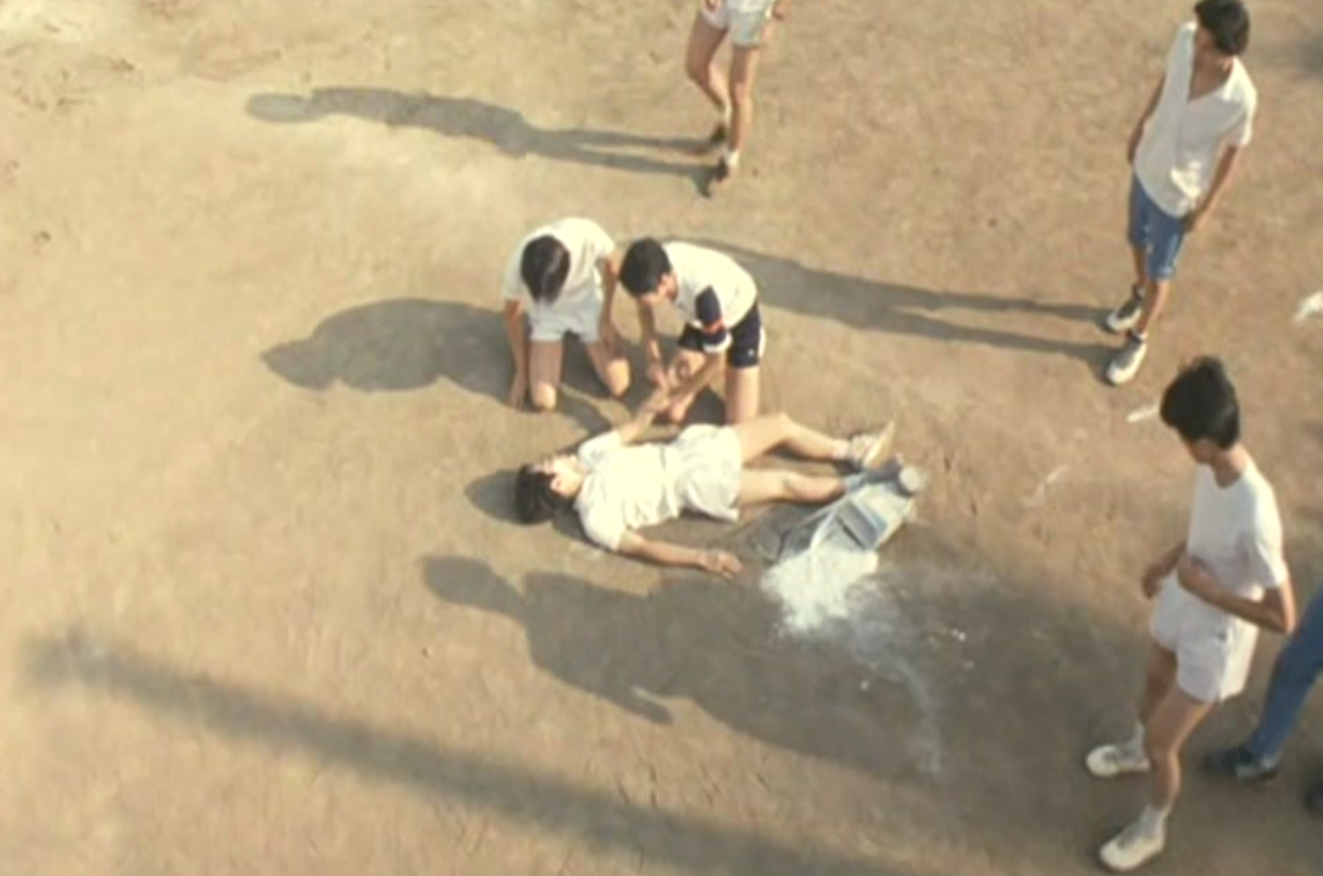kicking up the sand
by Douglas Messerli
Ryosuke Hashiguchi (screenwriter and director) 渚のシンドバッド(Like Grains of Sand) / 1995
Perhaps
the literal translation of the Japanese title, “Sindbad of the Seashore,” is
more appropriate that the soap-operaish title it finally received, Like
Grains of Sand. For Hashiguchi’s 1995 film about high-school youths is
anything but sentimental or romantic, and it looks on nonjudgmentally for what
seems, at times, an eternal whirlpool of confusions, chaos, and joys for which
there appear to be no borders, little pause, and no end in sight. Adolescence,
as Hashiguchi makes clear, is not a narrative with a beginning and an end, but
a seeming mish-mash of events that hit and cut at all individuals from 15-18, affecting their entire lives.
Asian
Movie Pulse reviewer Ritesh Sharma nicely summarizes the conditions of two of
the major 5 figures of this film:
“The story revolves around a group of five
high school students in suburban Japan, each dealing with internal conflicts
that society has neither the language nor the patience to understand. Shuji [Ito], (Yoshinori Okada) the central figure in
this narrative constellation, is a quiet, introverted boy silently grappling
with his attraction to his male best friend, Yoshida. His inner world is a
terrain of shame and
longing, two emotions that Hashiguchi portrays not through grand speeches or
confessionals, but through lingering silences, loaded glances, and the
unbearable awkwardness of unspoken truths."
Within four minutes of the beginning of
this movie, Shuji has already passed out on account of his close proximity to
his beloved friend and the chalk dust their coach as sent them to retrieve from
a small storehouse.
“Meanwhile, we meet Kasane, a new girl at school, who arrives with a
guarded demeanor and carries with her the invisible baggage of a deeply
scarring trauma. While most films might reduce such a character to her
backstory, Hashiguchi is more interested in how trauma shapes a person’s
interaction with the world in the present. Kasane is quiet, emotionally
distanced, and often treated with suspicion or cruelty by her peers for being
different. But through subtle narrative layering, we begin to understand the source
of her guardedness and how much strength it takes for her to show up in the
world every day.”
The others include the boy with whom Shuji
is in love, Yoshida (Kōta Kusano), unaware at first of Shuji’s feelings for him;
the film’s awkwardly rambunctious comic figure, Tōru
Kanbara (Kōji Yamaguchi), whose behavior often hides his truly tender and
sensitive nature; and the insecure Shimizu (Kumi Takada), who Yoshida is
currently dating.
We also witness some of their home lives or
at least the world outside of the school of the three major actors of this comic
drama, but for the most part, as in West Side Story, with which this
film might strangely be compared, there is little adult supervision or
guidance, and when it appears it is inappropriate or utterly meaningless. This
is a film about youths having to daily deal with vortex of waves of emotion
(and bodies of water eventually become important to this movie) in which they
feel they are daily drowning.
For the most part, however, instead of
becoming a loud screech of terror, Hashiguchi’s film, for the most part, is played
out in evasion, uncompleted sentences, and silence.
As Sharma’s insightful review observes: “There
is no singular ‘plot’ in Like Grains of Sand in the conventional sense.
The film isn’t concerned with propelling the story forward, but rather with
allowing the characters’ lives to unfold in their own time. It’s not about
finding a destination but about observing the quiet detours and dead ends that
define teenage existence. In doing so, Hashiguchi captures something
fundamentally true about adolescence: that it is not merely a phase of
self-discovery, but often a prolonged state of confusion and invisibility…
The pacing [of the film] is deliberately
slow, almost stalling at times, and that works in its favor. Adolescence is
often a time of inertia, where emotions swirl within but life on the outside
appears deceptively still. Hashiguchi captures that tension with piercing
clarity.”
Since there is no real plot, I am freed
from having to account for a logical narrative. What I need share with the reader
is a few significant moments that help to explain and define the rest of the narrative-in-awash.
Perhaps the
most important moments of the film are when his fellow student peers begin to
perceive Shuji’s puppy-love admiration of all things to do with his friend Yoshida.
Their mutual awareness begins, as in many cases, with a satiric drawing in
chalk upon the classroom blackboard, which quickly intensifies to the usual
bullying of Shuji in front of the entire class, most of the others laughing and
enjoying the scene or, in the case of Tōru or Yoshida, standing in terror apart
from the others, afraid that any intervention might also label them as being
gay, or particularly in Yoshida’s case of being a gay accomplice.
It is Tōru who first moves to the fallen
victim, advising him never to argue with such torturers, for they will always
win, but to try to simply ignore them—a near impossibility in Shuji’s mind.
Soon after, when the others all leave,
Shuji finally faces Yoshida and reveals that it’s all true, that he doesn’t
just “like” his friend, but “likes him in a special way,” not even having the
full language yet to describe love. Yoshida attempts to accept the new love,
finally, after some debate and embarrassment, allowing Shuji to kiss him, but
his pushes back make it quite clear that his friend’s feelings are not fully accepted,
or in contemporary parlance, that he is straight and intends to remain so.
And a bit later, he discovers that someone
has attached a trinket of a trombone, the band instrument Shuji plays, on his
bicycle and he tosses the whole bicycle into the water as if he is totally
disgusted.
A short
while after, Shuji’s father, raising him alone, drags him to the local
psychiatric clinic where the doctor simply explains that they no longer treat
homosexuality as a medical disease, in some ways forcing the inattentive father
to back off, although Shuji does now regularly meet with the doctor—at one
point asking the terrifying but necessary question, “Am I weird?”—and putting
him, surprisingly, in the same space as fellow student Kasane, who he and
Yoshida don’t discover until later has been raped the previous year in another
school she attended, which explains some of her remote-seeming behavior. Shuji and Kasane, certainly the outsiders
of their school, develop a friendly rapport with one another, speaking words
that they seem unable to share with the others, Kasane even describing how to
visit her in her hometown, racing through the orange orchard to the ocean for a
swim before finally returning home. Together they also mock the “ooo’s and
ahhhs” seemingly required for true heterosexual love-making.

What we may have forgotten is that earlier
in this film, Tōru has expressed an interest in Shimizu
and his friend Yoshida in the school new-comer Kasane. Either by accident or
intention, Shuji now arranges to “accidentally” meet up, while pretending to
date Kasane, with Yoshida and Shimizu, Yoshida at first quite confused by even
seeing his friend date a woman, but also sharing more rapport with Kasane than
with his movie-date Kasane, whom he basically ignores.
A short time later, Shimizu ends up on
the roof with Tōru, another “accident” one can presume that was arranged by
Shuji.
Yoshida now also visits Kasane, attempting
to initiate sexual contact; but after his rejection of Shuji and his direct,
almost brutal approach to her regarding his feelings, she explodes in a mad rejection
of his behavior.
It is the end of the year, and the school
band director has chosen to abandon his plans to compete in a competition of
local bands, instead serving to host the others. Of the seniors only a few,
Yoshida and Shuji among them, are helping with the hosting.
Since the event with Yoshida, Kasane has
been missing, only Shuji aware that she has returned home. Overhearing other
local school band-members talking about Kasane’s rape, Yoshida finally
comprehends the girl’s behavior and wishes to simply apologize for his own near-rape.
He confronts Shuji about her whereabouts, but refuses to even discuss his
reasons for wanting to know.
Nonetheless, Shuji finally insists he will
take his dream-lover to her, as Yoshida follows, the two traveling by train to
the town, running through the orchard and pausing at the seashore, leading
Yoshida to believe Shuji has only taken him on a wild goose chase. He seeks out
Kasane and finds her nearby, apologizing for his behavior.
But that is not enough for the now much
wiser Kasane, who perceives that Yoshida loves her only because she is a woman
he can fuck, that real love, such as that expressed by Shuji, has been rejected,
that Yoshida too is a mere male brute, like so many of the others of his age,
just seeking out sex, not real love.
She temporarily escapes him, going for a
swim in the ocean waters, while nearby Shuji has put on her dress, the two of
them temporarily reversing position in their searches for understanding of the
shifting world around them.
Yoshida comes across them, furious to see
Shuji dressed as a woman, yet trying to plead again with Kasane for love, since
she is a woman. Testing him, she finally gives herself up to him, lying
passively in the nearby brush as he begins to mount her. But he soon finds it
impossible to continue and, putting his head upon her belly, breaks into tears.
Meanwhile, the Sindbad of our tale has
entered the ocean, a frightening event since he clearly cannot swim and is
fully clothed in Kasane’s dress.
With Kasane’s insistence, Yoshida swims
out to save him, bringing his body back to shore. Yet Shuji is still
unresponsive, and Yoshida must enter air through his mouth, which in this case, appears more like
a kiss. Only upon the third “kiss,” does Shuji “come back” to life, commenting
about Yoshida finally being able to demonstrate his love.
Now
disgusted with both males for their self-deceptions, Kasane begins to kick and
throw sand upon them, dropping it upon them through their hair and kicking it
up with her feet almost as if it were a strange Christian rite related to the
rending of ashes. She finally sits between them, doing the same thing to
herself, all of them purging their bodies of the errors of their ways. The film
ends in this surreal ritual, all of the three central figures realizing how
they and the society which they live embrace delimited notions of love, that hatred
and fear of homosexuality is directly connected to male abuse and misogyny of
women.

As
the two males return via train back to their free summers, they are still
confused, perhaps stunned by what they might have learned; yet Hashiguchi offers us no narrative catharsis, not even
solutions to their feelings of love; but we know now that they will suffer
through the rest of their adolescence with a wisdom the others do not and may
never possess. If tears stream down our cheeks it is not simply in the
recognition of what they have “come through,” but what we ourselves have needed
to recognize in becoming full adults. Those without that recognition will
perhaps not enjoy this film.
Los Angeles, June
15, 2025
Reprinted from My
Queer Cinema blog (June 2025).











